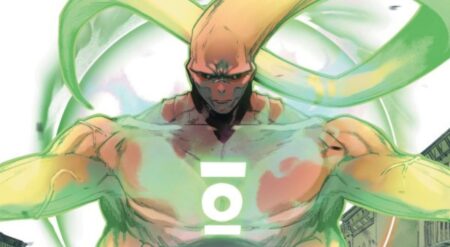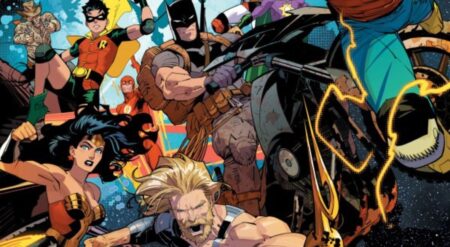
The plot of this first issue is structured to resemble a spy thriller, using a fractured timeline that sets the characters in motion. We shift from a flashback, hinting at the start of the war between the two agencies. As a spy thriller the twists begging quickly, with many of the key figures in danger already. The final page will create suspense that will last until the opening of the net issue.
What may be confusing inside Checkmate #1 is that the story seems to be in motion before the events inside this issue. The invitation for the individuals to join is hidden, and aspects of the plot are mentioned in dialogue instead of shown. This confusing timeline may take some time to settle into, but the characters involved may convince readers to continue to discover more. Bendis’ approach to a slower-paced narrative has initial promise.
The most unique aspect of this comic is the choice of cast. This is a large ensemble book, full of fascinating personalities and characters. Bendis has cast a wide net to capture the figures within this series, which will allow the plot to have multiple possible avenues to explore. There are the fighters in Green Arrow and Manhunter. Then there are the detectives and spies, such as Steve Trevor and the Question, with Director Bones also returning for fans of other Checkmate runs. The inclusion of Lois Lane will be interesting as it implies that this will be a comic that isn’t overly reliant on action and violence. In fact, the whole group presents a multitude of options into what genre this book can fit into.
The lead character of this issue is Talia, present in the flashback sequences. An assassin and detective, she appears to be the person with the biggest axe to grind with Leviathan and Shaw. There is also a lot of curiosity towards the leader of Checkmate; the enigmatic King. No one in the group truly trusts him, and any motives he may have are not present.
The dialogue is very similar to many of Bendis’ books, especially his most recent DC comics. There is a lot of dry humour and snarky remarks, which for the most part is funny and effective. With the sharp tongues that Talia, Lois, and Queen possess, their voices feel authentic. But there are a few instances where these voices start to be too similar to each other, lacking identities of their own. There are some lines that seem out of place, but when truly important, there are some conversations full of tension and surprise.
Long-time collaborator Maleev is the quintessential partner to Bendis on this book. The darkness of this comic makes the artist’s shadowy and scratchy line art the perfect fit. The spies and assassins meld with the shady surroundings as large shadows surround them. Each costume is beautifully crafted, from the smart casual of Trevor and Lane to the metal suit of Manhunter. Not just content within the small spaces., Maleev gorgeously renders wide shots of Metropolis’ skyline and the League of Assassins’ fortress, always creating fantastic locations.
The colours are superb and go very far towards affecting the atmosphere of Checkmate #1. The majority of the members of this organisation are most at home in the shadows, which Stewart accentuates brilliantly. But the light is always a colour that captures the attention, for example, the dusky orange inside Talia’s throneroom. But when Al Ghul is on a mission later in the issue, she finds herself in a brightly lit, shadowless large space, robbing her of places to hide. Just through colours, Stewart is delivering messages to the reader. There are many duller colours, such as brown or greys, but Green Arrow and Manhunter’s costumes stand out in their vibrancy.
The lettering is some of the most creative in comics. Reed has a very dynamic approach to his word balloons as when a character whispers or turns invisible, the words fade and shift. This is much more effective than the more typical technique of shrinking the text, as it demonstrates what is happening to the character’s voice.
Checkmate #1 is an entertaining start to the series but struggles to find its feet. The characters involved possess huge potential, the partnership of Maleev and Bendis reuniting is definitely exciting. However, the plot lacks forward momentum and true clarity. The art is stunning but most of the characters are yet to get involved. This comic needs to get moving to prevent readers from losing interest.
Checkmate #1 is available where comics are sold.






